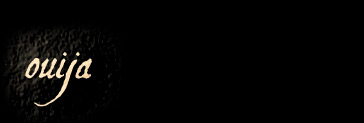
Contact | © 2007 | Robert Murch OUIJA® and MYSTIFYING ORACLE® are both trademarks of Hasbro, Inc. |

Search WilliamFuld.com
|
 |
 |
 |
 |
 |
 |
 |
|||
|
History | People | Boards | Stencils | Patents & Trademarks | Factories | Advertisements | Articles | Entertainment | Customer Letters | Other The Ouija Board Detailed History of William Fuld and the Ouija Board
Over the last century, spirit or talking boards have brought endless hours of entertainment to those who have dared to play. Spirit boards, witchboards, oracle boards, and mystery boards are all guises of the talking board. Though talking boards made their debut in America circa 1880, many precursor incarnations appeared by the mid-1800s in Europe. Edward O’Brian discovered the earliest known patent for a talking board in the patent offices in London, England. Adolphus Theodore Wagner, a professor of music and resident of Berlin of the Kingdom of Prussia, filed his patent for a “PSYCHOGRAPH, OR APPARATUS FOR INDICATING PERSONS THOUGHTS BY THE AGENT OF NERVOUS ELECTRICITY” on January 23, 1854. That was 30 years before the first talking board patent was even filed in the United States. This patent goes on to describe the device and identify it as a talking board. “The apparatus consists of a combination of rods or pieces of wood joined so as to permit of free action in all parts. From one of the legs of the instrument hangs a tracer; on one or more of the other extremities is fixed a disc, upon which the operator is to place his hand, and from this extremity or these extremities depends another tracer. The other parts of the apparatus consist of a glass slab or other non-conductor, and of an alphabet and set of figures or numerals. Upon a person possessing nervous electricity placing his hand upon one of the discs the instrument will immediately work, and the tracer will spell upon the alphabet what is passing in the operator’s mind.” It is quite curious that no mention of the spiritual or the occult occurs in his patent. This gentleman clearly believes that the messages spelled out by his device are created in the mind of the operator. This train of thought is duplicated throughout talking board patents. Though many spiritualists and practitioners of the occult claim to use talking boards to communicate with the other side, the inventors, or shall we say patentees, make no such claim. As you will see, almost from the beginning, talking boards began to take on lives of their own. Seven years later, similar devices were documented in Allan Kardec’s follow-up novel Le Livre des Mediums, translated by Anna Blackwell as “The Medium’s Book.” Allan Kardec, considered by many to be the father of French spiritualism, wrote detailed accounts of such talking board variants. The following full documentation can be found on page 160, under the section SEMATOLOGY AND TYPOLOGY: “In order to render spirit-communications independent of the medium’s mind, various instruments have been devised. One of these is a sort of dial-plate, on which the letters of the alphabet are ranged like those on the dial of the electric telegraph; a moveable needle, set in motion through the medium’s influence, with the aid of a conducting thread and pulley, points out the letters. We cannot help thinking, however, that the independence of the medium’s thought is insured as well by the raps, and that this independence is proved more conclusively by the unexpectedness and pertinence of the answers, than by all the mechanical contrivances yet invented for this purpose. Moreover, the incredulous, always on the lookout for wires and machinery, and are more inclined to suspect deception in connection with any special mechanical arrangements than with a bare table, devoid of all accessories. “A more simple contrivance, but one open to abuse, as we shall see in the chapter on Frauds, is the one devised by Madame Emile de Girardin, and by which she obtained numerous and interesting communications; for that lady accomplished and clever as she was, had the weakness to believe in spirits and their manifestations. The instrument alluded to consists of a little table with a moveable top, eighteen inches in diameter, turning freely on an axle, like a wheel. On its edge are traced, as upon a dial plate, the letters of the alphabet, the numerals, and the words “yes” and “no.” In the centre is a fixed needle. The medium places his fingers on this table, which turns and stops when the desired letters is brought up under the needle. The letters thus indicated being written down one after the other words and phrases are obtained, often with great rapidity. “It is to be remarked that the top of the little table does not turn round under the fingers, but that the fingers remain in their place and follow the movement of the table. A powerful medium might probably obtain an independent movement; in which case the experiment would be more conclusive, because less open to the possibility of trickery.” Interestingly, Kardec’s first line seems to completely contradict the last line of Wagner’s patent. The patentee states “the tracer will spell upon the alphabet what is passing in the operator’s mind.” Kardec’s states “In order to render spirit-communications independent of the medium’s mind…” So begins the division of the intended and actual use of the talking board. It wouldn't be long before the same would follow in North America. |
|||
